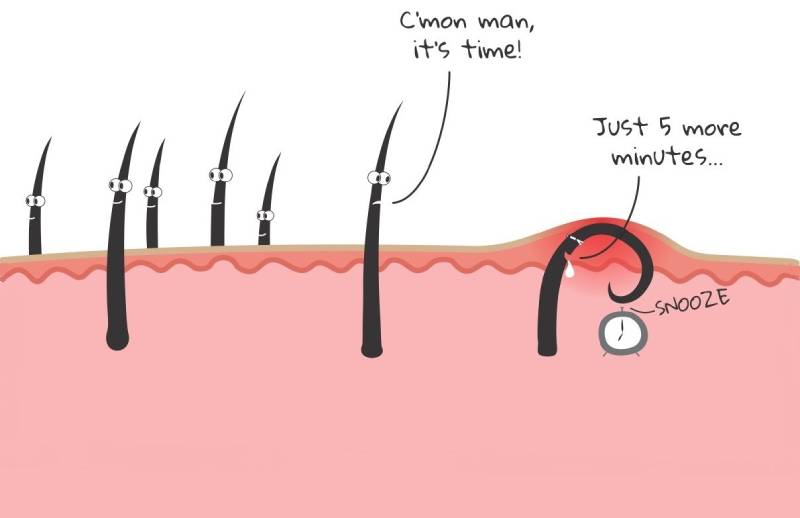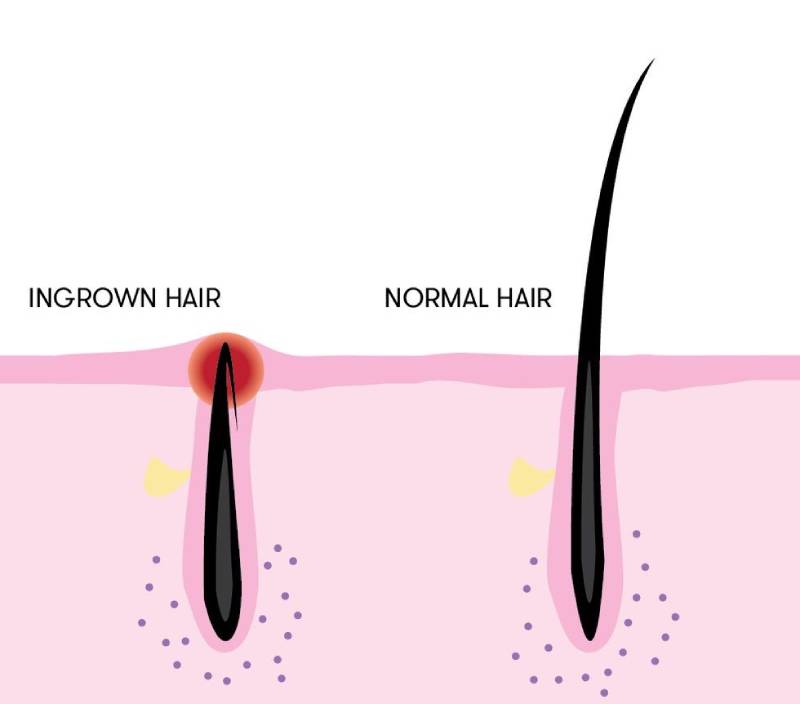
What Are Ingrown Hairs?
A hair becomes ingrown if it grows back into your skin while being outside of its hair follicle. The curlier the hair, the more likely it is to become ingrown. A hair can curve back into your skin as it grows out and becomes trapped under your skin. Friction is also a factor. So, wearing tight clothing such as leggings and jeans can contribute. Ingrown hairs trigger inflammation as they enter your skin. “The immune system sees the ingrown hair as a foreign object — much like a splinter,” explains Dr. Bullard. “The skin turns red, and pustules develop. These are dead white blood cells. Release of chemicals from the white blood cells is what leads to the inflammation and itching.”

How to Get Rid of Ingrown Hairs
Ingrown hairs can be a frustrating and unsightly problem for many people, causing discomfort and sometimes leading to skin irritation and infection. These pesky hairs occur when a hair curls back or grows sideways into the skin, instead of upward. They are common in areas where hair is frequently shaved or waxed, such as the beard, legs, bikini area, and underarms. In this blog, we’ll explore some effective methods to get rid of ingrown hairs and achieve smoother, healthier skin.
1. Exfoliate Regularly
One of the most crucial steps in preventing and treating ingrown hairs is regular exfoliation. Exfoliating removes dead skin cells and unclogs hair follicles, reducing the likelihood of hairs getting trapped beneath the skin’s surface. You can use a gentle exfoliating scrub, loofah, or exfoliating brush to slough away dead skin two to three times a week.
2. Proper Hair Removal Techniques
If you frequently experience ingrown hairs, it might be time to reconsider your hair removal techniques. Improper shaving or waxing can exacerbate the problem. Here are some tips for safe and effective hair removal:
- a. Shaving: Always use a sharp, clean razor and shave in the direction of hair growth. Avoid pulling the skin too tightly while shaving, and use a moisturizing shaving cream or gel to reduce friction.
- b. Waxing: Ensure that your skin is clean and dry before waxing. Apply the hard wax in the direction of hair growth and pull it off swiftly in the opposite direction. Afterward, soothe the area with a cooling, alcohol-free gel or aloe vera.
3. Don’t Pick or Squeeze
Resist the temptation to pick, scratch, or squeeze ingrown hairs. Doing so can lead to infection, scarring, and further inflammation. If the ingrown hair is bothering you, apply a warm, damp compress to the area to help reduce swelling and bring the hair closer to the surface.
4. Use Salicylic Acid
Salicylic acid is a beta hydroxy acid that helps exfoliate the skin and reduce inflammation. Look for skincare products containing salicylic acid and apply them to the affected area. This can help break down the dead skin cells and free the trapped hair.
5. Moisturize Daily
Keeping your skin well-hydrated is essential for preventing ingrown hairs. Dry skin can lead to more friction and irritation during hair removal, increasing the likelihood of ingrown hairs. Use a moisturizer that suits your skin type daily to maintain soft and supple skin.
Topical retinoids, derived from vitamin A, can help prevent ingrown hairs by promoting cell turnover and reducing the risk of clogged hair follicles. However, consult a dermatologist before using retinoids, as they can cause skin sensitivity.
Conclusion
Ingrown hairs can be bothersome, but with the right approach, you can effectively prevent and treat them. Remember to exfoliate regularly, practice proper hair removal techniques, and avoid picking or squeezing ingrown hairs. Incorporate salicylic acid, moisturizers, and retinoids into your skincare routine to maintain smooth and healthy skin. For persistent cases, don’t hesitate to seek professional advice. By following these tips, you’ll be well on your way to a hair-free, ingrown hair-free, and confident you!



Comments